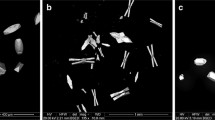Abstract
Solid-phase interactions and speciation are important to radioiodine transport in groundwater. At the Hanford Site in Southeastern Washington State, iodate (IO3−) is the main aqueous species in dilute radioiodine groundwater plumes. Like other oxyanions, IO3− may be incorporated into and/or adsorbed onto calcite, a common mineral at Hanford, decreasing its mobility in the environment. A series of macroscale batch experiments combined with solid-phase characterization were conducted to identify variables impacting time-dependent aqueous IO3− removal via calcite precipitation and determine the location of IO3− within the calcite crystal structure. Results demonstrated 11.5–97% aqueous IO3− removal during initial rapid calcite precipitation. Incorporation was apparently the main removal mechanism, although later slower precipitation and/or adsorption may have also contributed to IO3− removal. Using a higher concentration of the calcite-forming solutions (i.e., using 1 M vs. 0.1 M concentrations) resulted in an increase in the amount of precipitated calcite and a greater percentage of IO3− removed; however, calcite formed with lower molarity solutions resulted in higher IO3− mass (µg/g) removal. Solubility testing of laboratory-produced calcites showed only small differences in solubility for calcite with and without IO3− incorporated into the structure. Evidence collected from SEM/FIB and TEM/SAED suggested that the IO3− incorporated into calcite was present in regions close to the surface (implying potential easy release upon calcite dissolution).





Similar content being viewed by others
References
Campayo L, Grandjean A, Coulon A, Delorme R, Vantelon D, Laurencin D (2011) Incorporation of iodates into hydroxyapatites: a new approach for the confinement of radioactive iodine. J Mater Chem 21:17609–17611
Coulon A, Laurencin D, Grandjean A, Coumes CCD, Rossignol S, Campayo L (2014) Immobilization of iodine into a hydroxyapatite structure prepared by cementation. J Mater Chem A 2:20923–20932
Kaplan D, Santschi P, Xu C, Zhang S, Ho Y, Li H, Schwehr K (2012) Laboratory report on iodine (129I and 127I) speciation, transformation, and mobility in Hanford groundwater, suspended particles and sediments. SRS.
Kaplan DI, Denham ME, Zhang S, Yeager C, Xu C, Schwehr KA, Li HP, Ho YF, Wellman D, Santschi PH (2014) Radioiodine biogeochemistry and prevalence in groundwater. Crit Rev Environ Sci Technol 44:2287–2335
Kerisit SN, Smith FN, Saslow SA, Hoover ME, Lawter AR, Qafoku NP (2018) Incorporation modes of iodate in calcite. Environ Sci Technol 52:5902–5910
Lu ZL, Jenkyns HC, Rickaby REM (2010) Iodine to calcium ratios in marine carbonate as a paleo-redox proxy during oceanic anoxic events. Geology 38:1107–1110
Neeway JJ, Kaplan DI, Bagwell CE, Rockhold ML, Szecsody JE, Truex MJ, Qafoku NP (2019) A review of the behavior of radioiodine in the subsurface at two DOE sites. Sci Total Environ 691:466–475
Podder JLJ, Sun W, Pan Y, Botis SM, Tse J, Chen N, Hu Y, Li D, Seaman J (2015) Uptake and speciation of iodinein calcium carbonates. In: 35th annual Canadian Nuclear Society (CNS) conference, Saint John, NB, Canada
Podder J, Lin J, Sun W, Botis SM, Tse J, Chen N, Hu Y, Li D, Seaman J, Pan Y (2017) Iodate in calcite and vaterite: Insights from synchrotron X-ray absorption spectroscopy and first-principles calculations. Geochim Cosmochim Acta 198:218–228
Riley BJ, Vienna JD, Strachan DM, McCloy JS, Jerden JL (2016) Materials and processes for the effective capture and immobilization of radioiodine: a review. J Nucl Mater 470:307–326
Saslow SA, Kerisit SN, Varga T, Johnson KC, Avalos NM, Lawter AR, Qafoku NP (2019) Chromate effect on iodate incorporation into Calcite. ACS Earth Space Chem 3(8):1624–1630
Serne RJ, Serne JN, Bjornstad BN, Last GV, Schaef HF, Smith SC, Williams BA, Lindenmeier CW, Lanigan DC, Zachara JM, Horton DG, Burke DS (2008) Characterization of vadose zone sediment: uncontaminated RCRA borehole core samples and composite samples. Pacific Northwest National Laboratory, Richland
Tang YZ, Elzinga EJ, Lee YJ, Reeder RJ (2007) Coprecipitation of chromate with calcite: batch experiments and X-ray absorption spectroscopy. Geochim Cosmochim Acta 71:1480–1493
Xu C, Kaplan DI, Zhang S, Athon M, Ho Y-F, Li H-P, Yeager CM, Schwehr KA, Grandbois R, Wellman D, Santschi PH (2015) Radioiodine sorption/desorption and speciation transformation by subsurface sediments from the Hanford Site. J Environ Radioact 139:43–55
Zhang Z, Strickland CE, Field JG, Parker DL (2011) T-TY tank farm interim surface barrier demonstration-vadose zone monitoring FY10 report. Pacific Northwest National Lab (PNNL), Richland, WA (United States)
Zhang S, Xu C, Creeley D, Ho Y-F, Li H-P, Grandbois R, Schwehr KA, Kaplan DI, Yeager CM, Wellman D, Santschi PH (2013) Iodine-129 and iodine-127 speciation in groundwater at the Hanford Site, US: iodate incorporation into calcite. Environ Sci Technol 47:9635–9642
Acknowledgements
This document was prepared by the Deep Vadose Zone—Applied Field Research Initiative at Pacific Northwest National Laboratory. Funding for this work was provided by the U.S. Department of Energy (DOE) Energy Management and Richland Operations Offices. The Pacific Northwest National Laboratory is operated by Battelle Memorial Institute for the DOE under Contract DE-AC05-76RL01830. Solid-phase characterization including XRD, SEM/EDS, FIB, TEM, and SAED were performed in the Environmental Molecular Sciences Laboratory (EMSL), a national scientific user facility sponsored by the Department of Energy's Office of Biological and Environmental Research. The authors would like to thank those who analyzed samples, reviewed data, and helped with experimental equipment, including Keith Geiszler, Steven Baum, Ian Leavy, Megan Nims, Michelle Valenta Snyder, and Ben Williams.
Author information
Authors and Affiliations
Corresponding authors
Additional information
Publisher's Note
Springer Nature remains neutral with regard to jurisdictional claims in published maps and institutional affiliations.
Electronic supplementary material
Below is the link to the electronic supplementary material.
Rights and permissions
About this article
Cite this article
McElroy, E., Lawter, A.R., Appriou, D. et al. Iodate interactions with calcite: implications for natural attenuation. Environ Earth Sci 79, 306 (2020). https://doi.org/10.1007/s12665-020-09023-1
Received:
Accepted:
Published:
DOI: https://doi.org/10.1007/s12665-020-09023-1




